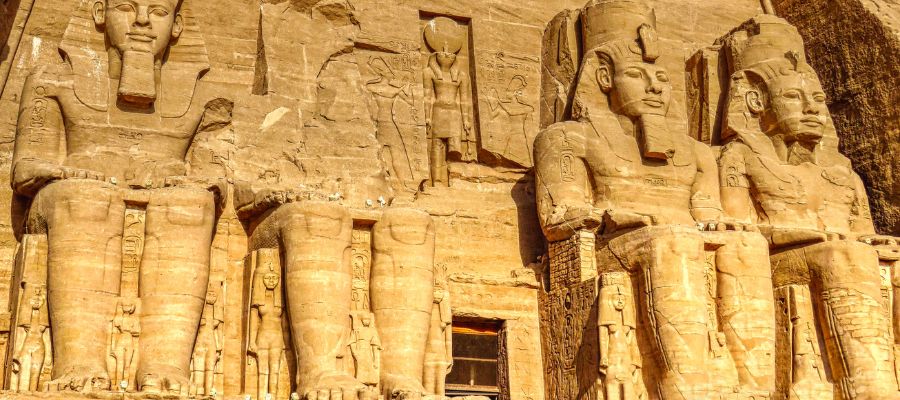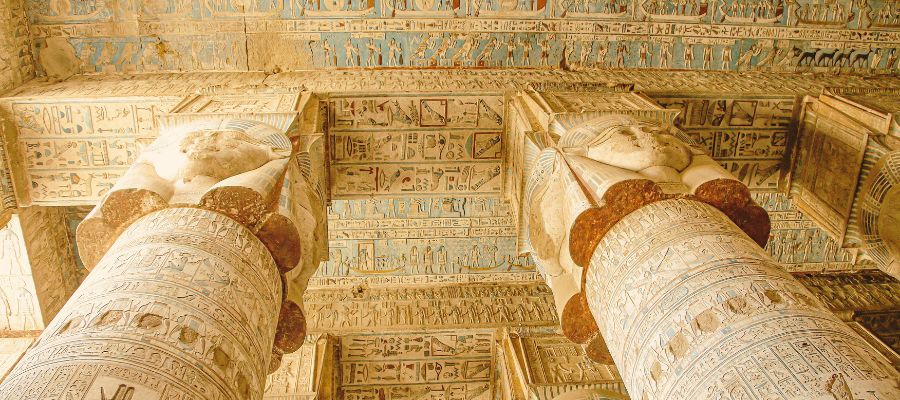Abu Simbel Temples are a fascinating destination for tourists. Constructed over 3,000 years ago by Ramesses II, the temples were forgotten and slowly covered with sand. They were rediscovered in the early 19th century, and later moved to higher ground due to the rising waters caused by the Aswan High Dam. The Great Temple of Abu Simbel is dedicated to the gods Amon-Ra, Ra-Harakhti, and Ptah, while the Small Temple is dedicated to Queen Nefertari. Tourists can visit the temples on a day trip from Aswan or when flying between Cairo and Aswan.

All You Need to Know About Abu Simbel Temples
Abu Simbel Temples are two individual rock-cut temples built during the reign of King Ramses II in the 1200 B.C. period, located in Aswān muḥāfaẓah, southern Egypt.
The construction of the temple started in 1264 BC and lasted for 20 years. The main temple is dedicated to King Ramses II, while the smaller one is dedicated to his wife, Queen Nefertari, for the worship of the goddess Hathor.
The four colossal statues of Ramses in front of the main temple are examples of ancient Egyptian art, while the temple itself is dedicated to the sun gods Amon-Re and Re-Horakhte.
In the mid-20th century, the temples were at risk of being submerged by the reservoir created by the construction of the nearby Aswan High Dam. UNESCO and the Egyptian government sponsored a project to save the site, which involved completely disassembling and reconstructing both temples on higher ground.
Abu Simbel, Philae, and other nearby monuments were collectively designated a UNESCO World Heritage site in 1979.
When to Visit Abu Simbel Temples for the Best Experience
Abu Simbel Temples, located in the southernmost part of Egypt, are known for their stunning architecture and rich history. If you want to have the best experience while visiting this beautiful temple complex, then timing your visit is crucial.
The best time to visit Abu Simbel Temples is in the morning, between 4 am to 10:30 am. During this time, the sun is at an angle that illuminates the interiors of the temples, creating a spectacular sight. This is especially true for the Great Temple of Ramses II, which features a special solar alignment on February 22 and October 22 every year, when the sun shines directly into the inner sanctum of the temple, illuminating the statues of Ramses II, Ra, and Amun.
Aside from the spectacular lighting effects, visiting during the morning hours also allows you to avoid the scorching heat of the afternoon. The temperature can rise to as high as 40°C during summer, which can make exploring the temple complex uncomfortable.
Here are some additional tips to help you plan your visit to Abu Simbel Temples:
- Avoid visiting during major holidays or peak tourism season (December to February) to avoid large crowds and long queues.
- Wear comfortable shoes and clothing suitable for the hot and arid climate.
- Hire a knowledgeable guide or purchase an audio guide to learn more about the history and significance of the temple complex.
- Respect the local culture and customs by dressing modestly and refraining from taking photographs in prohibited areas.
In conclusion, timing your visit to Abu Simbel Temples is crucial to ensure the best possible experience. Visiting in the morning hours not only allows you to witness the stunning lighting effects, but also helps you avoid the scorching heat of the afternoon. Remember to plan ahead, dress appropriately, and respect the local customs to make the most out of your visit.
10 Must-Do Activities at Abu Simbel Temples
Abu Simbel is one of the most popular tourist attractions in Egypt and offers a variety of activities for visitors to enjoy. Here are 10 must-do activities at Abu Simbel Temples:
1. Discover Abu Simbel: Exploring an Ancient Temple Complex
Exploring the entire temple complex is highly recommended once you arrive at Abu Simbel. Within the complex, you'll discover exquisite sculptures and statues that are definitely worth taking the time to appreciate. Strolling around the temple complex is highly encouraged as there are also fascinating ancient ruins to discover. Understanding the purpose behind the construction of Abu Simbel is also crucial to fully appreciate the significance of this ancient marvel.
2. Aswan Governorate: A Must-Visit Destination
After exploring the temple complex, you may want to unwind by the beautiful Lake Nassar before flying back to Aswan. If you have time, you could also consider taking a short trip to Aswan Governorate. By referring to the Abu Simbel temples map, you can easily find your way to the site.
3. Luxor Hiring: Drive to Nearby Attractions
Embark on an exhilarating journey by taking a road trip from Aswan to Abu Simbel temples via Luxor. Along the way, make a pit stop at the Philae temple and marvel at the impressive High Dam in the vicinity of Aswan. The scenic drive is sure to be a rejuvenating experience. Should you feel the need to take a breather, feel free to pause your journey and rest. The fascinating Abu Simbel temple facts are sure to captivate you along the way.
4. Rock Temples Bus Tour: Uncovering Ancient Wonders
Regular tours to the Abu Simbel temples from Aswan are available on air-conditioned buses. These buses typically depart early in the morning and take you to two rock temples situated on the banks of Lake Nassar. During the journey, free distilled water is provided to the passengers. Visiting the Abu Simbel temple in Egypt is a must-see landmark of the region.
5. Bike Rental: Explore the Area at Your Own Pace
In Aswan, renting a bike is also an option for those who are interested. By doing so, you have complete freedom to go wherever you please, though it may take a bit longer. This bike ride to Abu Simbel is sure to be an enjoyable experience. Additionally, the relocation of the Abu Simbel temple is a significant historical event that continues to play a vital role to this day.
6. Light and Sound Show: An Enchanting Evening Experience
Make sure to catch the stunning light and sound show that narrates the complete story of the temple, including that of Ramesses II. As the show begins, the entire atmosphere transforms, making you feel as though you have been transported to that era. You'll witness a plethora of intriguing hidden facts being unveiled in a beautiful manner. Don't let this opportunity pass you by. The laser show runs regularly and is highly regarded by visitors. The show requires a minimum of 10 people to commence. Rest assured, the experience is absolutely phenomenal and not to be missed.

7. Interior Exploration: Discovering Hidden Gems
The temple's interior houses a plethora of sculptures and ancient statues that are worth exploring, not to mention the UNESCO-listed complex. Historians often visit this place to gather valuable information about the temples. The Abu Simbel airport is well connected to the temple via various means of transportation, making it easily accessible to tourists and history enthusiasts alike.
8.Get a Guide: Enhancing Your Travel Experience
To learn about the history of the two temples and their creator, Ramesses II, it is recommended to hire a guide. The temple walls are engraved with writings, which can also be explored, although it may take some time to read through them.
9. Tuya Café: Indulge in Delicious Breakfast and Coffee
For a delightful breakfast experience, Tuya Café is a highly recommended option. Set in a beautiful garden, this café serves delicious local cuisine and offers a serene atmosphere that is perfect for tourists. In addition, the café allows smoking for those who desire it. Many travelers choose to stop at this popular spot to unwind and savor the delectable food.
10. Temple of Hathor: Journey to an Ancient Wonder
The Temple of Hathor is a must-see attraction at Abu Simbel, located adjacent to the Temple of Ramesses. It features statues of Ramesses and Nefertari, with the latter depicted in the guise of Hathor. The temple is renowned for its intricate depictions of queens offering dedications to the gods, showcased on the walls. The artistry is exceptionally graceful, making it a popular draw for visitors.

Getting to Abu Simbel Temples: A Travel Guide
Abu Simbel Temples are a must-visit destination in Egypt. Here is a travel guide to help you plan your trip to Abu Simbel:
- Abu Simbel can be visited on a day trip from Aswan or when flying between Cairo and Aswan.
- Roundtrip flight from Aswan is the fastest way to reach Abu Simbel. Egypt Air offers two round-trip flights per day between Aswan and Abu Simbel. The flights are direct and take 45 minutes one-way.
- Egypt Tailor Made is a highly-rated tour company that offers a private day trip to Abu Simbel from Aswan. Sofitel Old Cataract Hotel and Movenpick Hotel can arrange a day trip to Abu Simbel by land.
- When flying to Abu Simbel, Egypt Air provides a free bus service between the Abu Simbel airport and the temple complex. The bus waits for you at the temple complex parking lot while you tour the temples.
- If you plan to visit Abu Simbel on the way from Cairo to Aswan or vice versa, you can book a multi-hop flight.
Interesting Facts About Abu Simbel Temples
- The temples of Abu Simbel were built over 3,000 years ago by Ramesses II, one of the most powerful rulers of ancient Egypt.
- The Great Temple is dedicated to the gods Amon-Ra, Ra-Harakhti, and Ptah, while the Small Temple is dedicated to Queen Nefertari, Ramesses II's beloved wife.
- The construction of the two temples took twenty years and was completed in 1244 BC.
- The temples were forgotten and covered with sand until rediscovered in the early 19th century by Jean-Louis Burckhardt and Giovanni Battista Belzoni.
- The entire complex was dismantled and moved to higher ground to avoid being flooded by the rising water levels caused by the Aswan High Dam in the 1960s.
- It took over 50 countries and 5 years of work to save the temples from being submerged.
- Today, visitors can admire the temples and marvel at their impressive history and the monumental effort it took to preserve them.
Like
Dislike
To obtain a Egypt eVisa
- Step1: Complete the online application by providing your passport details.
- Step2: Submit payment online using a credit card.
- Step3: Monitor your email for confirmation of payment and receipt of your eVisa, which will be sent electronically.


Comment